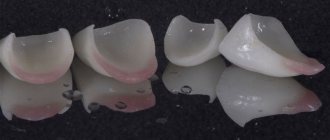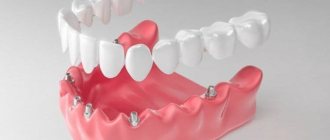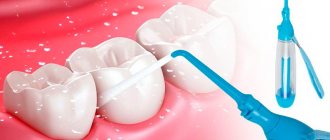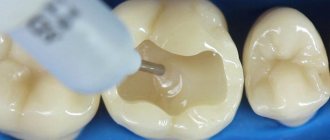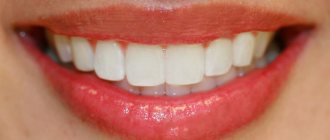3453
Not all people have a sparkling, beautiful smile, as there are many factors that can affect aesthetics. One of the conditions for healthy teeth and the entire oral cavity as a whole is correct bite.
In particular, orthognathic occlusion, which is the subject of today’s article, falls into this category.
What is orthognathy
Translated from Greek, “gnathos” means jaw, and “ortho” means straight or regular.
In dentistry, orthognathic is a physiologically correct bite. Its main feature is a slight overlap (up to 1/3 of the crown height) of the lower teeth with the upper ones. This occlusion is considered the most advantageous from an anatomical and physiological point of view (which we will talk about later). Other characteristics of correct occlusion include straight teeth and tight grip of the incisors (there are no gaps between them).
General overview
To begin with, it is worth defining that occlusion in dentistry means the specificity of the occlusal closure of the teeth during clenching of the jaws. The correct ratio is considered to be one in which full functionality is maintained and the aesthetics of the facial contour are not disturbed.
From the point of view of finding the optimal option, the best option is considered to be the orthognathic or normagnothic form of occlusion. This, among other things, is implied in the name itself - in ancient Greek, the word “orthognathia” means “straight upper jaw.” This structure is characterized by the location of the arch and facial bone in the same vertical plane, close contact of the incisors, as well as the impeccable shape of the jaw.
Orthognathic bite: how to determine
The surest way to determine the type of occlusion is to consult a dentist for an examination. Orthognathic bite has the following features, which can be determined independently:
- The upper teeth overlap the lower teeth by 1/3 (or less) of the crown height. This is the basis of a physiological bite. It is important to note that if the closure is direct (when the edges of the upper teeth directly meet the edges of the lower teeth), then this is a type of pathological bite, although such a smile looks very aesthetically pleasing. With such closure, the teeth quickly wear out and are destroyed.
- One upper tooth meets the two lower ones.
- Middle line. Many people mistakenly believe that the middle of the upper jaw should coincide with the middle of the lower jaw. In fact, it is important that the midlines of the upper jaw and face coincide.
- You do not feel any functional impairment. The processes of chewing and swallowing are not accompanied by discomfort and pain. If clicking or crunching is felt, this indicates dysfunction of the temporomandibular joint (TMJ). This symptom is often observed with pathological bites.
- Correct facial proportions. This is an indirect characteristic for physiological occlusion. There are cases when pathological closure of teeth does not affect the symmetry of the face. There are also opposite cases when those with a correct bite have an asymmetrical face. An individual approach and correct diagnosis by a doctor are important here.
What does an orthognathic bite look like?
Orthognathia: benefits
- Uniform load on teeth . This protects hard tissues from premature destruction.
- No speech impediment . With pathological occlusions, a violation of diction is often observed, since some sounds are difficult for a person to hear.
- No strain on the digestive organs . With an incorrect bite, a person chews food poorly. Relatively large pieces of food enter the stomach, which impairs digestion.
- Effective oral hygiene . The correct shape of teeth is the key to good hygiene. In this case, the risk of developing caries, periodontitis and other dental diseases is significantly reduced.
- Successful dental treatment . People with malocclusion experience difficulties with prosthetics, implantation and other types of dental treatment. Often, before the main treatment, the doctor prescribes bite correction.
- Aesthetic benefits . In most cases, an orthognathic bite provides a beautiful smile and facial symmetry.
Types of abnormal bite
An abnormal bite is characterized by incorrect location of the alveolar openings of the molars or incisors, the presence of congenital anomalies of the bone structure of the head, and post-traumatic violation of occlusion. To correct it, trainers, braces are used, and surgery is performed.
Deep bite
The front upper incisors cover the upper ones by more than ⅓. In severe situations, their end ends at the gums of the lower teeth. The contact between the incisors and molars is disrupted. An alternative name for occlusion is traumatic, frontal overbite, decreasing, disocclusion.
A person develops “bird-like” facial features. The upper half flares out, so the chin looks abnormally narrow. The lower lip is turned outward, the mouth is small. With a deep bite, difficulties arise when chewing food, injuries to the mucous membranes, and thinning of the enamel.
Often pathological occlusion leads to deterioration of the oral cavity:
- severe headaches;
- decreased tone of the chewing muscles;
- dysfunction of the temporomandibular joint;
- friction of the mucous membranes of the cheeks, the appearance of wounds.
Deep occlusion can in most cases be corrected with long-term retainer therapy.
Open bite
The pathological process is characterized by a strong vertical displacement of the dentition of the jaws. An open bite develops due to sucking on pacifiers and fingers. Bad habits gradually shift the dentition. The sucking reflex can be traced even in adulthood: unconscious sucking or biting of the tongue.
Pathological occlusion is diagnosed when the molars are in close contact, but a large gap forms between the lower and upper incisors. Surgery is performed in the presence of speech therapy disorders or pain during eating.
Crossbite
Crossed occlusion occurs in people who use only one side of the jaw or incisors to chew food. The development of a pathological process can be provoked by a congenital anomaly of the jaw, a mechanical injury, as a result of which the chin is shifted to the left or right.
This type is considered one of the most severe dental diseases. Unilateral cross occlusion can be diagnosed if one or more of the upper incisors extend beyond the lower ones. A bilateral violation is accompanied by a displacement of the entire jaw, in which the dentition does not close simultaneously on the left and right sides.
Occlusion in childhood can be provoked by:
- rickets;
- cleft palate;
- lack of calcium and vitamin D;
- cleft lip;
- inflammatory process in the temporomandibular joint;
- disturbances in the development of cranial bones during embryonic development.
To treat crossover anomalies, the Herbst device and metal braces are used. In case of congenital diseases, plastic surgery is performed to restore the palate.
Distal bite
Such occlusion is diagnosed when the upper jaw is highly developed, and the lower jaw is narrowed and small in size. The teeth on top move forward, almost completely covering the bottom ones. The root elements do not close, and vertical cracks form. Distal occlusion is diagnosed with various types of prognathia.
Along with the anomaly, speech disorders are formed. Speech therapy disorders prevent a person from speaking normally: pronouncing hissing consonants and guttural sounds. When occlusion occurs, the shape of the face changes. Due to a strongly protruded jaw, the lower lip sinks, the chin looks massive and heavy.
Mesial bite
An alternative name is reverse, progeny. Pathological occlusion is detected with pronounced development of the lower jaw. At the same time, the orthodontist notes that it is moving forward greatly. In this position, closure of neither the molars nor the anterior incisors is possible.
The situation is the opposite of an orthognathic bite - the lower jaw overlaps the upper jaw. In severe cases, gaps form between the incisors, which prevents normal biting and chewing of solid food. The gap between the teeth is clearly visible when a person smiles. The main load falls on the chewing molars.
Immediate surgical intervention by an orthodontist is required only in cases where traumatic occlusion is diagnosed using x-rays. In this position of the jaws, the development of constant bleeding is observed. Regular injuries to soft tissues lead to chronic gum disease, because the lower ones completely cover the upper incisors.
Against the background of the reverse, cross and open occlusion occurs. In this case, it is difficult to implant prostheses. When progeny occurs:
- three and curvature of the lower dentition;
- crowding;
- formation of tartar, caries, inflammation of soft gum tissue;
- early loss of canines and molars;
- thinning of cartilage tissue, pain, difficulty in chewing movements.
How does a correct bite develop?
You need to monitor your bite from early childhood. Pay attention to the position of the tongue, the position of the teeth and the development of the child’s jaw. Let's consider the main stages of bite formation in children of different ages.
- 0-6 months . During this period, the foundation for the closure of the dentition is laid. If the child is fed correctly (so that the masticatory muscles experience the proper level of load), then the dental arches and jaws develop harmoniously (if there are no hereditary or congenital anomalies of the dental system).
- 6 months . The first milk teeth appear, the tongue rests on the roof of the mouth.
- Up to 3 years . Closer to 3 years of age, baby teeth are formed. At this age, the child’s dentofacial arches are fully functioning, he is able to chew food normally and speak.
- 4 years . From this age, the milk bite gradually loses its position.
- 6 years . Permanent teeth appear in place of the lost milk teeth. An overlap of the lower teeth with the upper teeth is formed (no more than 1/3 of the height of the crown). If the child had gaps between the teeth in the primary dentition (tremas or diastemas), then by the time the permanent dentition is formed, these defects disappear.
- 15 years . In adolescents, the formation of dentition ends. The overlap of the upper teeth with the lower ones should remain at 1/3 of the height of the crown.
Bite after wisdom tooth removal
Some doctors are convinced that wisdom teeth are an atavism and must be gotten rid of. In ancient times, they were used to chew tough foods, such as raw meat. With the development of civilization, the human diet changed, his jaw began to gradually decrease - and the “eights” turned out to be superfluous. Most often, before starting to correct the bite, wisdom teeth are removed. This frees up space for the correct formation of rows, and the result of teeth alignment will be much better.
The importance of physiological occlusion
Physiological occlusion is important for health for the following reasons:
- the bone tissue of the skull elements develops harmoniously;
- uniform load on teeth and joints;
- no negative effects on the digestive or respiratory system;
- correct facial proportions, lack of psychological discomfort in this regard;
- beautiful smile;
- good oral hygiene.
Diagnostics
The correctness of the bite is determined by the orthodontist at the appointment. Such a specialist is available in any dental clinic - both for children and for adults.
He determines the correct position of the teeth and also selects a method for correcting it. Already during the initial examination, large gaps between bone formations, their crowding, extra teeth or knocking them out of the general row are noticeable.
For more accurate diagnosis, X-ray equipment is used. Such an image allows you to clearly determine the distance between the teeth, the location of the jaws relative to each other, the presence or absence of large gaps between bone formations. Also, an x-ray will show how best to correct the bite in the presence of pathologies.
Anatomy and physiology of the dental system
When it comes to occlusion, not only the location of the teeth is important, but also the functions of the remaining elements of the dental system. These are the upper and lower jaws, jaw joints and muscles that ensure the process of chewing and swallowing.
The greatest load on the teeth occurs when chewing. It is important that at this moment the load is evenly distributed on the surface of the teeth. This way hard tissues will retain their strength and structure longer. Otherwise, the teeth will quickly wear out. This threatens with caries, wedge-shaped defect, gum disease and final tooth destruction.
Under the physiological norm, the position of the jaws should be parallel. The lower jaw resembles a parabolic arch, and the upper jaw is a semi-oval. The coordinated functioning of the jaw joints is also important - without discomfort, clicks and crunches.
What affects the bite of teeth?
The negative impact of defects in the dental system on the condition of the entire organism has been repeatedly proven by scientists. The list of identified health risks is impressive even for ardent optimists.
- Due to improper distribution of the chewing load, tooth enamel wears off faster, teeth begin to react painfully to cold and hot, their necks become exposed, and noticeable gaps form between the teeth.
- Diseases of the temporomandibular joints occur, accompanied by headaches and a characteristic clicking sound when the jaws move.
- The aesthetics of the face suffers: its proportions change, wrinkles form, teeth become crooked, and the smile becomes unattractive.
- It becomes difficult to bite food, chewing functions are disrupted, causing diseases of the gastrointestinal tract.
- Speech defects appear, facial expressions are distorted, and self-esteem decreases.
- Crowding and crooked teeth cause accelerated tooth decay due to frequent chipping and carious lesions.
- The oral mucosa is injured - cheeks, gums, tongue, and the tissues of the oral cavity become inflamed.
- The quality of breathing deteriorates, which leads to diseases of the nasopharynx, trachea, and hearing aid.
What are the problems with orthognathic occlusion?
Orthognathia does not guarantee the absence of dental problems. Even with a physiologically correct bite, various defects are possible. These include:
- crowded teeth;
- diastema and trema - gaps between teeth;
- edentia (absence of one or more teeth);
- speech defect;
- other violations.
Important. Under no circumstances should you neglect such defects in your primary bite. Many parents believe that baby teeth are not that important because they will soon fall out. This is a big misconception, since the health of permanent teeth largely depends on the condition of baby teeth. Therefore, if you want your orthognathic bite to be preserved in the future, then take care of your teeth from early childhood.
Treatment of dental malocclusion
How to change the bite of teeth? Pathologies of the dental system can only be eliminated through orthodontic treatment. An exception is the correction of a low bite, when the height of the teeth decreases with age due to their wear. In such cases, the bite is corrected by dental prosthetics with crowns or veneers, as well as by implantation. Other anomalies of teeth and bite can be removed at any age with special orthodontic structures or through surgical intervention.
However, maxillofacial operations are performed only in case of serious deviations from the norm. Usually, to correct dental malocclusion, doctors suggest correction with braces or aligners.
Now that you know about all the health risks that can cause pathologies of the dental system, and how to correct your dental bite, all that remains is to take specific actions. Even if at first glance it seems that your teeth are straight, make an appointment with an orthodontist. Diagnosing the condition of the dentition will help maintain the health of other organs and systems. And timely orthodontic treatment will make your smile more attractive and significantly reduce the number of future visits to the dentist.
Correct bite: how to maintain
Pathological bites are formed due to hereditary or external factors. If we cannot influence genes, then we can change our lifestyle. To avoid malocclusion, we recommend adhering to the following rules:
- Wean your child off bad habits - thumb sucking, cheek biting, excessive use of the pacifier.
- Provide normal nutrition - introduce solid food in a timely manner so that the jaw experiences normal load.
- Treat respiratory diseases. The child should breathe through his nose. Mouth breathing is one of the risk factors for the formation of a pathological bite.
- Treat dental diseases in a timely manner.
- Visit your dentist regularly for preventative checkups.
- Use an orthopedic pillow while sleeping.
Reasons for the formation of pathology
There may be several components that provoke the formation of pathology.
Internal:
- Provided that the child’s parents are diagnosed with an incorrect bite relationship of the jaws; teeth with non-standard anatomy, size or location - with a high probability the pathology will be inherited.
- Disorders of intrauterine fetal formation, diseases of women during pregnancy (anemia, intrauterine infections), trauma during childbirth.
External:
- Failure to comply with the rules of natural and artificial feeding by parents in infants is fraught with the formation of pathological closure of the HF and LF. The hole in the nipple should be small so that the baby can perform chewing and sucking manipulations.
- It is important to pay attention to bad habits at home, because psychosomatics are involved. Make sure that when sleeping on the side the child does not place his hand under his cheek - there may be a danger of developing a unilateral defect. Tension in your sleeping position can also interfere with the smooth development of your mouth. A child’s harmful habit of constantly sucking a finger, pacifier, and other objects threatens to form a malocclusion.
- It is necessary to monitor the nutritional balance in children at any age. It is important to maintain optimal amounts of fluoride, calcium and other minerals in the body. If you determine a violation of their metabolism, contact your pediatrician.
- Poor posture in a teenager, when the head goes forward and the back goes back, leads to a greater development of high frequency than low frequency.
- Problems with nasal breathing, together with ENT pathologies, lead to pathologies in the formation of the jaws.
- It is important to promptly treat caries and maxillofacial pathology, restore early loss of milk units; Avoid injury, fractures, and prosthetic errors.
- You should pay attention and monitor the formation of the rudiments of wisdom teeth (eights), remove them in time to prevent displacement of the dental units.
FAQ
Why is correct bite important?
Correct bite means a reduced risk of not only dental, but also other diseases. With pathological occlusion, the load on the teeth is uneven, which leads to accelerated wear of some teeth.
In addition, malocclusion is an additional burden on the digestive system and respiratory organs. Finally, there is psychological discomfort due to facial disproportion.
Can the bite be incorrect if the teeth are straight?
Yes. The straight bite mentioned above can be formed with straight teeth. Therefore, the ideal shape of the teeth can also be observed in pathological occlusions that require orthodontic correction. In addition to straight teeth, straight teeth can also be observed in deep, distal or open bites.
Correct jaw anatomy - what is it?
The main sign of a physiologically correct jaw is its shape. The lower jaw resembles a parabola, while the upper jaw resembles a semi-oval. This is how the teeth are located on the corresponding jaws.
Both jaws should be symmetrical along an imaginary vertical line that runs between the central upper teeth.
What is the correct tongue position?
The entire tongue (both tip and back) should touch the roof of the mouth.
How to recognize an abnormal bite?
Above we looked at the criteria for correct bite. Therefore, deviations from these signs can be considered incorrect occlusion. At the same time, you cannot make diagnoses yourself. Consult a doctor who will accurately determine the type of bite. Let us remind you that among pathological bites the following are distinguished:
- distal – the upper teeth hang excessively over the lower teeth;
- mesial – the lower jaw protrudes strongly forward;
- deep – the upper teeth overlap the lower teeth by more than half;
- open – the presence of a sagittal gap between the teeth;
- cross – displacement of one jaw relative to the other (displacement towards the teeth, molars and premolars);
- straight - the closure of the lower edges of the upper and lower teeth during occlusion.
In what cases may treatment be required?
Typically, treatment by an orthodontist is not for those who have a physiologically correct orthognathic bite. However, the structural features of the dentofacial system in some cases may require a certain correction even with this type of bite:
- Sometimes, with an orthognathic bite, a problem may arise with teeth that are uneven in relation to the rest in the row .
Treatment in this case requires changes in appearance - this situation can greatly spoil the impression of a smile and cause psychological discomfort. - One of the possible problems is that the incisors are too large in relation to the rest of the row . In this case, the closure remains correct in all respects, but a discrepancy occurs in the position of the teeth.
The structure of the dentofacial apparatus is characterized by individual characteristics for each patient, so there may be other cases that require the intervention of an orthodontist.
